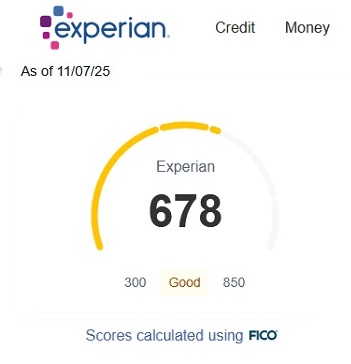|

not a Dow Jones company
|
THE MUST KNOW INFORMATION BEFORE APPLYING FOR LOAN OR CREDIT CARD

IS YOUR CREDIT score 604 or 678? The answer is probably both.
BEFORE you apply for a loan to save an unnecessary and unsuccessful hard inquiries on your FICO report
IT IS IMPORTANT to know the credit system your bank or credit card company uses
Background
In 2006 there was a quiet revolution in the finance industry that has consistently damaged and confused borrowers with good FICO scores when they are turned down for loans and credit cards. The quiet revolution has a name and it is the VantageScore3 credit score system owned jointly by the three major U.S. credit bureaus: Equifax, Experian, and TransUnion and it is far harsher then a FICO score
While both FICO and VantageScore3 aim to predict a borrower's creditworthiness and use similar underlying credit report data, they differ in their specific calculation methodologies, data requirements, and the weight they assign to various factors. (see below) to produce a completely differing creditworthiness
The dangerous irony of double dinging
The ironic situation occurs when a person with a FICO score of 670 out of 850, which his considered good, is turned down for a loan or a credit card by an institution that uses the VantageScore3 system that has assessed their creditworthiness as 604 out of 850 which is classed as poor. And the refusal then dings both the person's FICO and VantageScore3's score
Below is a side by side comparison of the credit score for the same person on the same day.
This consumer was refused a credit card by Chase who uses VanageScore3 BUT granted a card by CitiBank who use the Experian FICO score by Chase And both ran a hard inquiry on the subscriber
|
A real world side by side comparison of the two scores published by Experian
|
FICO

| Minimum Credit History |
Requires at least six months of credit history with an active account reported to a bureau within that period. |
| Data Evaluation |
Primarily uses a "snapshot" of your credit data at a specific time. Primarily uses a "snapshot" of your credit data at a specific time. |
| Alternative Data |
Rarely incorporates alternative data like rent or utility payments, unless those accounts are in collections. |
| Hard Inquiries (Rate Shopping) |
Offers a 45-day grace period where multiple inquiries for specific loans (mortgage, auto, student) count as a single inquiry. |
| Collections Accounts |
Ignores paid collections and unpaid collections with an original balance under $100. |
| Weighting of Factors |
Assigns specific percentages to categories (e.g., payment history is 35%, credit utilization is 30%).while age and type of credit are "highly influential"), which can lead to different scoring outcomes for the same data. |
| Usage by Lenders |
The industry standard; used by approximately 90% of top lenders for most loan types, including mortgages and auto loans. |
|
VantageScore3.0

| Minimum Credit History |
Can generate a score with as little as one month of credit history and one account reported within the past two years. |
| Data Evaluation |
Uses trended data, which looks at patterns of borrowing and payment behavior over a period (up to two years in some models). |
| Alternative Data |
Actively incorporates on-time rent, utility, and telecom payments into the score calculation if they are reported to the credit bureaus. |
| Hard Inquiries (Rate Shopping) |
Has a 14-day grace period for multiple inquiries, but it applies to a wider range of credit types, including credit cards. |
| Collections Accounts |
Ignores paid collections but includes all unpaid collections regardless of the original amount. |
| Weighting of Factors |
Assigns relative "influence" levels to categories (e.g., payment history is "extremely influential," while age and type of credit are "highly influential"), which can lead to different scoring outcomes for the same data. |
| Usage by Lenders |
Often used by personal finance sites for consumer education and increasingly by credit card issuers and some auto lenders. |
|
| |
|
THIS EDITION'S SPONSOR
|
![The Street Wall Journal image]()
Gilbert & George by Roger Molloy
(c) Copyright 2025
|
London-based photographer Roger Molloy is known for his unique approach to displaying his work
.
- Mobile Phone Photography: Molloy is notable for creating a significant portion of his photographic art using his mobile phone's camera, demonstrating that a "proper" camera isn't necessary to pursue artistic passion.
- Bethnal Green Roots: Molloy is originally from Bethnal Green, East London, an area often referred to as a hub for artistic expression.
- Unique Display Methods: He initially gained recognition for displaying his prints as a montage on his own front door. He later transformed his home into a gallery to showcase his work.
- Inspiration from London Life: Molloy's art is deeply inspired by the vibrant life and surroundings of London.
- Overcoming Challenges: After losing his photographic equipment, Molloy started his collection anew, embracing the creative possibilities of mobile phone photography.
> You can find a short film showcasing Molloy's journey from displaying art on his front door to creating a home gallery on the BBC website. There are also mentions of his work and images on Flickr and Facebook. Roger Molloy |
Email editor@TheStreetWallJournal.com for a free subscription delivered to you mailbox
copyright 2022/25 The Street Wall Journal - an Art Wall Company -All Rights Reserved
|



